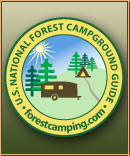Forest Information
The Sheyenne National Grassland (NG) located in the southeast
corner of North Dakota and one of four grasslands in the Dakota
Prairie Grassland, is 70,268 acres - see map below. The grassland
is administered by Dakota Prairie Grasslands office. There is one
developed campground which meets the selection criteria.
Like most of North Dakota, the Sheyenne National Grassland was
shaped by glaciers over 10,000 years ago. As the ice melted and
the towering glaciers receded, the glaciers left great deposits
of sand. The melting glacier fed Lake Agassiz and carried silt
and sand that formed a vast delta. Lake Agassiz is long gone but
wind and rain over the eons have shaped the delta's silt and sand
into the rolling topography of Sheyenne NG.
Located where east meets west, the Sheyenne NG is home to a
wealth of unique wildlife and plant species. Some of the last
stretches of tall grass prairie in North Dakota are found in this
grassland. Visitors to the Sheyenne NG may be fortunate enough
to see a Sharp-tailed grouse or a Fox squirrel. More often seen
are raccoons, Wood ducks, or Coopers hawks, just to mention a few
animals that make the Sheyenne NG their home.
The Western Prairie Fringed Orchid is a spectacular and
endangered plant found in the Sheyenne NG. Sharp eyes might spot
this delicate blossom in a roadside ditch during the month of
July. The Sheyenne NG boasts the largest population known for
this flower. Much more plentiful and easier to spot are the
Brown-eyed Susan, Prairie roses and Purple coneflowers growing
along roadsides in the grassland.
Near the town of Hankinson, ND is the Sheyenne NG's only
campground. Hankinson Hills campground is nestled among rolling
grass-covered sand hills. Grand old oaks tower above campsites
and provide ample shade for campers. An eight-mile trail winding
through the sand hills, is popular with both hikers and horse
back riders. Like the trail, Hankinson Hills campground welcomes
horses and their riders as well as campers without horses. Each
group has their own separate section in the campground.
North of Hankinson Hills campground, adjacent to the North Country
Trail and near the Sheyenne River, is Jorgen's Hollow campground.
Welcoming both equestrian and non-equestrian campers, this campground
was once the home of Jorgen Haugen, who homesteaded here in 1939.
Today, there is little left of the old homestead except towering trees,
the surrounding sand hills and delightful songs of Meadowlark.
The Sheyenne NG has one of the last patches of "virgin" (meaning
it has never been mowed) prairie in North Dakota. It is from
this "virgin" prairie that the Forest Service is collecting the
seeds of native plants so they can return the land to the prairie
it once was. (GPS coordinates - N46 23.623, W97 27.541)
The areas now designated as "grasslands" were settled in the
1800s under a variety of "Homestead Acts" which opened the land
to people, generally farmers, and helped to settle the west. A
prolonged period of drought in the late 1920s into the 1930s
caused some homesteads on sub-marginal farmland (a location
receiving 15 or less inches of annual moisture) to literally dry
up and blow away. During this time, Congress established the Land
Utilization Program (LUP) which purchased homesteads from
bankrupt private owners and returned them to public land status.
The Civilian Conservation Corps (CCC) helped to stabilize the
eroding soil by re-seeding and applying other conservation
techniques. In the 1950s, the LUP holdings were assigned to the
USDA, Forest Service which was tasked with management of these
sub-marginal lands. Over the years the Forest Service has
established some twenty National Grasslands. "The designation of
the area as National Grassland is not a description of the area
as much as a statement of policy and effort to restore the area
to a multiple of uses and benefits."
The Sheyenne River winds its way through most of the Sheyenne NG,
its banks held in place by basswood, ash, and oak. The River,
like the land, has changed greatly since the glaciers
disappeared. Today, the Sheyenne River's flow is only a fraction
of what it was during those long ago days when the glaciers were
receding. The land, once shifting and wind-blown, is now
anchored by the returning grass. The Sheyenne NG is slowly
recovering from the damage done to it and invites all to discover
a grassland in transition.

ADDRESSES
SUPERVISOR ADDRESS
2000 Miriam Circle
Bismarck, North Dakota 58501
701-989-7300
RANGER DISTRICT ADDRESS
Sheyenne
1601 Main Street
P.O. Box 946
Lisbon, ND 58054
701-404-8950 |
